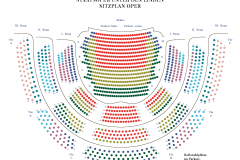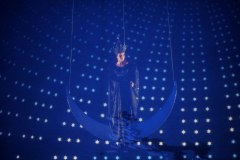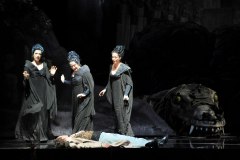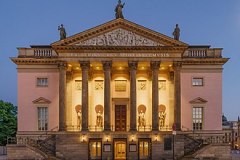The Magic Flute
Mo | Tu | We | Th | Fr | Sa | Su |
GRAND OPERA IN TWO ACTS (1791)
MUSIC BY Wolfgang Amadeus Mozart
TEXT BY Emanuel Schikaneder
It is one of the classics in the Staatsoper’s repertoire: August Everding’s production of Wolfgang Amadeus Mozart’s »The Magic Flute«. The production is unique for its reconstruction of Karl Friedrich Schinkel’s 1816 set design for what was then the Berlin Court Opera on Unter den Linden – including the legendary starry sky for the Queen of the Night, which has become an icon of scenography and continues to enchant audiences.
However, director Everding’s production was no museum piece: he brought to life the world portrayed on stage – which was based on almost two-hundred-year-old designs – through a timeless, spirited staging, which premiered at the Staatsoper in 1994, but remains every bit as witty and humorous today. Prince Tamino is saved from a giant serpent at the last minute by the three ladies of the Queen of the Night. The ladies then show him a picture of the queen’s daughter, Pamina, and he immediately falls in love with her. Together with the happy-go-lucky bird-catcher Papageno, he sets off on a journey to find his love, who is – as he discovers – being held captive by the sun priest Sarastro. In order to prove themselves worthy of the women they love, Tamino and Papageno must pass various difficult trials. Alongside the new production of »The Magic Flute« by Yuval Sharon, the Everding production will continue to enrich the Staatsoper’s repertoire. The direct comparison offered by two productions of the same work invites audiences to observe the opera from two different perspectives.
PLOT
BACKGROUND
In a mythical past, a king and queen ruled together over a kingdom of day and night. Their daughter was called Pamina. When the king died, he gave his power – symbolized by the mighty circle of the sun – not to the queen, but to the Brotherhood headed by Sarastro, thereby dividing the realm of light and shadow in two. After the king’s death, however, his wife attempted to win back the power she had lost as the Queen of the Night. In order to remove Pamina from her mother’s negative influence, Sarastro has had her kidnapped.
ACT ONE
While hunting, the young prince Tamino is lured into the realm controlled by the Queen of the Night and threatened by a monster. Fearing for his life, he loses consciousness. The Three Ladies who attend the Queen of the Night quarrel over the unconscious young man. When the prince awakes, the bird catcher Papageno tells him where he is. On the queen’s orders, the Three Ladies give Tamino a portrait of the princess Pamina, and he falls instantly and deeply in love. The queen attempts to use this love to recover Pamina and, with her, the powerful circle of the sun from Sarastro. Tamino is determined to free Pamina from Sarastro. Papageno is told to accompany him, and both are equipped with magic instruments, a flute and a set of bells. Three Boys are to guide them as good spirits. In the meantime, Pamina attempts to flee Sarastro’s control in order to escape the cruel slave overseer Monostatos. Papageno, however, finds her and tells her that Tamino loves her, and they flee together. When Tamino meets the Speaker of the Brotherhood at the gates of the temple, he begins to doubt what he has heard of Sarastro’s evil intentions. In his uncertainty, he turns to the invisible higher powers and, for the first time, discovers his flute’s magic powers. Pamina and Papageno’s attempt to flee is thwarted by the arrival of Sarastro, but Pamina decides to tell Sarastro the truth. She and Tamino meet. Sarastro has Tamino and Papageno brought to the Temple of Wisdom. As a woman, Pamina cannot accompany them.
ACT TWO
Sarastro asks the members of the Order to let Tamino face the trials that will initiate him into the Brotherhood and, at the same time, announces that he intends for Pamina and Tamino to wed. As their first trial, Tamino and Papageno are forbidden to speak, an utter impossibility for Papageno. The Queen of the Night sees that her plans are being foiled by Sarastro. She forces her way into the temple and calls on Pamina to kill Sarastro. Sarastro, however, uses humanity and forgiveness to fight the queen’s desire for vengeance. The Three Boys return to Tamino and Papageno the magic instruments that were taken from them before their admission to the temple. Pamina cannot understand Tamino’s silence and doubts his love. She decides to kill herself and is stopped by the Three Boys at the last moment. In the end, the two lovers pass the final, decisive test in the temple of fire and water together. In the meantime, Papageno, too, decides to kill himself because the Papagena he had found at last has been taken from him. Here, too, the Three Boys arrive to save him. Monostatos allies himself with the Queen of the Night, but their attack is thwarted and the sun banishes the darkness. Together with the Queen of the Night, Sarastro is able to turn over the mighty circle of the sun to the new king and queen, Tamino and Pamina.
Program and cast
Duration: approx. 3:00 hrs including one interval after act one
Language: In German language with German and English surtitles
Recommended age: 8 years and older
CAST
MUSICAL DIRECTOR: Eva Ollikainen
DIRECTOR: August Everding
SET DESIGN: Fred Berndt nach Karl Friedrich Schinkel
COSTUMES: Dorothée Uhrmacher
LIGHT: Franz Peter David
SARASTRO: René Pape
TAMINO: Bogdan Volkov
PAMINA: Serena Sáenz
PAPAGENO: Carles Pachon
PAPAGENA: Serafina Starke
QUEEN OF THE NIGHT: Kathryn Lewek
SPEAKER: Roman Trekel
MONOSTATOS: Florian Hoffmann
THREE LADIES: Clara Nadeshdin , Rebecka Wallroth , Anna Kissjudit
1.PRIESTERL: N.N.
2.PRIESTER: Roman Trekel
1.GEHARNISCHTER: Andrés Moreno García
2.GEHARNISCHTER: Manuel Winckhler
3 KNABEN: Solisten des Kinderchors der Staatsoper
STAATSOPERNCHOR
KINDERCHOR DER STAATSOPER
STAATSKAPELLE BERLIN
State Opera Unter den Linden
Staatsoper Unter den Linden is one of Berlin's most prestigious opera houses, with a rich history and significant cultural impact.
History:
The Staatsoper Unter den Linden was originally built between 1741 and 1743, under the direction of architect Georg Wenzeslaus von Knobelsdorff. It was commissioned by Frederick II of Prussia and was initially named the Königliche Oper (Royal Opera). The opera house has undergone several renovations and reconstructions, notably after World War II damage. It reopened in 1984, following a major renovation.
Construction:
The original design was characterized by its Baroque style, featuring an elegant façade and a grand entrance. The building was reconstructed in the 1950s and 1980s, maintaining its classical exterior while modernizing the interior. The façade features a classic portico with six Corinthian columns and a prominent central pediment.
Interior:
The interior is known for its opulent and classical design. The auditorium is renowned for its acoustics and grandeur, with luxurious velvet seats and elaborate decorations. The stage and seating areas have been updated to meet modern performance standards while preserving historical aesthetics.
Concerts and Performances:
The Staatsoper Unter den Linden hosts a variety of performances, including operas, orchestral concerts, and ballet. It is home to the Staatskapelle Berlin, one of Germany's leading orchestras. The opera house is celebrated for its high-quality productions and its role in Berlin’s vibrant cultural scene.
JOURNEY
The Staatsoper Unter den Linden has completely barrier-free access due to its excellent public transport connections.
ADDRESS: Unter den Linden 7; 10117 Berlin
SUBURBAN RAILWAY
S+U Friedrichstraße (S1, S2, S5, S7, S25, S75)
SUBWAY
Hausvogteiplatz (U2)
Museumsinsel (U5)
Stadtmitte (U2, U6)
Unter den Linden (U5, U6)
BUS
Staatsoper (100, 245, 300)
Unter den Linden/Friedrichstraße (100, 147, 245, 300, N6)
PARKING
Q-PARK parking garage Unter den Linden/Staatsoper
Bebelplatz, 10117 Berlin
There are five electric charging stations in the parking garage. Further information can be found here.
The underground car park on Bebelplatz offers disabled parking spaces and direct access to the opera house. On entering the car park between 5.30pm and 11.30pm, the maximum parking fee is €7. To use this tariff, enter your parking ticket in one of the pay machines and the message »Theatertarif« will appear on the display. Please note that it is not possible to use the tariff if you enter the car park before 5.30pm. so it will not be shown on the display. TIP: If you pay the theatre tariff at the pay machine before the event, you can avoid unnecessary waiting after the show.

 EN
EN DE
DE IT
IT FR
FR ES
ES RU
RU JP
JP RO
RO
 Seating plan
Seating plan 

